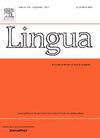The semantic typology of expressive interjections: colexifications in pain, disgust and joy interjections across languages
IF 1.3
3区 文学
0 LANGUAGE & LINGUISTICS
引用次数: 0
Abstract
Expressive interjections are most likely a universal feature of human languages, yet for the moment we know very little about their typology. This article presents the first broad-scale cross-linguistic study on the semantic typology of expressive interjections. Specifically, the study examines colexification patterns, i.e. which experiences tend to be expressed by the same interjections. Based on lexicographic sources, we assembled a data set of 523 interjections expressing pain, disgust or joy in a diverse sample of 144 languages. We then inventoried which other meanings (or ‘colexifications’) associate with these three experiences. The analysis revealed that pain, disgust and joy all associate with a large and diverse set of experiences, with significant overlap. However, there are strong contrasts regarding the most prevalent colexifications, delineating a number of experience clusters. Pain interjections often express generic negative emotions, sorrow, fear, and compassion. Disgust interjections often express dislike or disapproval, contempt, and to some extent irritation. Joy interjections often express admiration, approbation and congratulations. Pain and disgust associate preferentially with negative experiences, and joy with positive experiences. At the same time, disgust and joy share a preference for socially-oriented experiences, which is not matched by pain. Importantly, all three experiences frequently associate with surprise, presumably because it is neutral in valence. The pivotal role of surprise in the semantic networks delineated by interjections is a question for future research.
表达感叹词的语义类型:痛苦、厌恶和快乐感叹词的跨语言共化
表达性感叹词很可能是人类语言的一个普遍特征,但目前我们对它们的类型学知之甚少。本文首次对表达性感叹词的语义类型进行了大规模的跨语言研究。具体来说,该研究考察了共色化模式,即哪些经历倾向于用相同的感叹词来表达。基于词典编纂来源,我们收集了144种不同语言样本中523个表达痛苦、厌恶或喜悦的感叹词的数据集。然后,我们列出了与这三种体验相关的其他含义(或“共化”)。分析显示,痛苦、厌恶和快乐都与大量不同的经历有关,并且有显著的重叠。然而,对于最普遍的共化,有强烈的对比,描绘了许多经验集群。疼痛感叹词通常表达一般的负面情绪,悲伤、恐惧和同情。厌恶的感叹词通常表达不喜欢或不赞成,蔑视,以及某种程度上的愤怒。喜悦感叹词通常表达钦佩、赞同和祝贺。痛苦和厌恶倾向于与消极的经历联系在一起,而快乐倾向于与积极的经历联系在一起。与此同时,厌恶和喜悦都倾向于社会导向的体验,这与痛苦不同。重要的是,这三种体验经常与惊喜联系在一起,大概是因为它的效价是中性的。惊讶在感叹词描述的语义网络中的关键作用是未来研究的一个问题。
本文章由计算机程序翻译,如有差异,请以英文原文为准。
求助全文
约1分钟内获得全文
求助全文
来源期刊

Lingua
Multiple-
CiteScore
2.50
自引率
9.10%
发文量
93
审稿时长
24 weeks
期刊介绍:
Lingua publishes papers of any length, if justified, as well as review articles surveying developments in the various fields of linguistics, and occasional discussions. A considerable number of pages in each issue are devoted to critical book reviews. Lingua also publishes Lingua Franca articles consisting of provocative exchanges expressing strong opinions on central topics in linguistics; The Decade In articles which are educational articles offering the nonspecialist linguist an overview of a given area of study; and Taking up the Gauntlet special issues composed of a set number of papers examining one set of data and exploring whose theory offers the most insight with a minimal set of assumptions and a maximum of arguments.
 求助内容:
求助内容: 应助结果提醒方式:
应助结果提醒方式:


